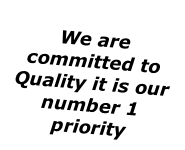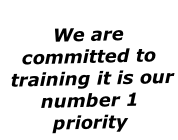






















Do you have an adequate training policy?
A training policy should recognise the value of effective communications and demonstrate commitment. Let’s just explore this word commitment. We often see the word, boldly printed on polices, proudly displayed in an organisations reception. Policies for health and safety, quality, the environment, customer service etc. Each one defying logic as a number one. Should we ask the real number one to step forward?
All too often these policies are just empty words because the word commitment has never been understood to mean resources. So invariably inadequate amounts are spent on any of them. And training itself is just crowded out with all these other ‘number 1’ priorities.
Try and ensure that you have an up-to-date training policy in place with some real commitment to spending. And ask: with all those number 1’s are your communications sending the right message?
Are there any basic rules we need to consider to help ensure this will be an effective video?
There are certain ‘do’s and don’ts’ we have learned over the years that can help ensure success. One of the ways of being sure that you are getting honest feedback on the success of your programme is to join the audience anonymously. The lessons can be painful. At Green Training Works we often organise trial training sessions using our programmes to test their effectiveness before final release - this provides the opportunity to make amendments in post production and to overcome any unforeseen or unintended effects. These sessions can also double up as ‘train the trainer’ or ‘training materials familiarisation’ sessions, depending on the client’s needs.
Things to avoid
If possible avoid putting the CEO on the front of the video to ‘demonstrate commitment’. Although no one will admit it, the CEO often has no charisma whatsoever and will be hated and mistrusted by most of the audience. This may be contrary to the official line but you know it’s true. Also, Chief Execs will say nothing of any worth - they are not daft enough to do that on camera as they might be held to account for it later. So take our advice, avoid the CEOs at all costs. If you have to include them don’t do it as a ‘talking head’ in the office - get them out on the site, ideally being asked questions by one of your target audience - at least that way there is some chance of credibility.
But our video does need a lot of ‘talking heads’
That’s Ok, just so long as the interviews are fully illustrated - so we can see what they are talking about.
Don’t use celebrities to present the video unless you have a very good justifiable reason. There is no evidence to demonstrate that the effectiveness of a training video improves with the use of known celebrities to present it - in fact it may do the opposite. Just because a famous face may be used to sell products or a brand doesn’t mean it should be used in training. The same goes for using the ‘famous’ for voice-overs. You don’t want the audience to spend half the time trying to identify the voice instead of listening to what is being said. Our advice is that unless you have a very good argument to the contrary - save your money or put it into other production values.
What are production values? And why are they important?
In a dramatised production for example high production values are essential to helping the audience suspend disbelief. As audiences become more sophisticated that becomes more difficult and more expensive. That’s why some vintage videos look so corny, a modern audience expects much higher production values than they did even a few decades ago.
An idea may be a good one but the budget may simply not be adequate to make it work effectively - the lack of ‘production value’ can mean mockery from the audience and a loss of face for those responsible.
























Your video may be intended to:
- Communicate information
- Change Attitudes
- Develop Skills
- Develop interest
- Or raise issues - using trigger videos for example – these are ‘open ended’ and therefore they need to be supported in some way.
But whatever the intention of the video it is clearly far more important than just something to ‘put on during coffee’ or to ‘liven up’ a training session.
A video should be treated as something far more important than just something to ‘put on during coffee’ or to ‘liven up’ a training session.


Training and communications - some rules and myths

Similar problems can arise when a client becomes fixated on using popular music tracks. These can be very expensive and negotiating the rights to a single tune can blow a hole in the budget. Most music written for video can be easily cleared for use at known prices via the Mechanical Copyright Protection Society (MCPS). This makes budgeting much easier. However the rights to use most popular songs have to be individually negotiated, which can involve more than one writer and several performers. Once again - unless you have a good reason avoid going down this road.
There is a myth that has grown up amongst the training community that a training video should be no more than 7 minutes long. How on earth this magic number was arrived at we don’t know. The optimum length is dependent on many different factors and there is no ‘one size fits all’. You will easily sit through a film at the cinema for a couple of hours, without the ‘magic number’ kicking in after the first few minutes... if the film is a good film... if it has good production values. However, if it’s going to be a ‘bad’ film you can probably tell within the first few seconds. So the real question is not about length but about production value. However, having carried out many training sessions using video in many different industries we find our audiences sitting intently for at least twenty minutes. Sometimes the video may be much longer but to ensure integration with the rest of the training and to reinforce retention, we tend to portion longer programmes into these twenty minute segments.
It all depends on content - on what you have to say and if that’s going to take all day you are not going to cram it into 7 minutes.
Stick to the rules
New isn’t always better
Don’t discard old rules because they are old
They are old rules because they work
For example narrative is usually a fairly essential ingredient – what’s your story – what’s the journey – what’s the quest – what’s the question?
Curiosity is a powerful human driver. It’s very difficult to resist wanting to know the answer to a question. Of course the question has to be in some way relevant to your life or interest. For example the question: what is the cube root of 14678? is not one that most of us would be particularly desperate to answer to but if we said: ‘The secret of eternal youth is held in the cube root of 14678’ - we might be be a bit more interested.
So a narrative can be composed of a series of questions and as we answer each one, we draw the audience deeper into the programme and further into the story.
When the rules are ignored
When the rules are ignored the result is disaster. Just think of all the boring films you’ve seen. When the programme is just a series of facts: “the ancient Greeks did this and then the ancient Greeks did that and then they did this again” - it is not a recipe for gripping TV.
So the programme should be relevant to the audience
It should ask questions.
It should take them on a journey – it should have narrative – it should tell a story.
It should include theory and show how it is applied in practice, with principles demonstrated by examples.


| Pollution Prevention |
| Waste |
| Awareness |
| Resource Efficiency |
| H&S, Energy and Other |
| Browse by Category |
| Browse by Cover |
| Directors Comments A Way With Waste |
| Director's comments |
| Presentation tips for new trainers |
| Green Training Views |
| Irony gets a hat |
| Why Use Video? |
| Unofficial Laws |
| ALL ARTICLES |
| Directors Comments |
| Scrapbook |
| Your Training Objectives |
| Training and Communications |
| Beware the price |
| Briefing |
| Pitfalls |
| Production Experience |
| CONTACT |